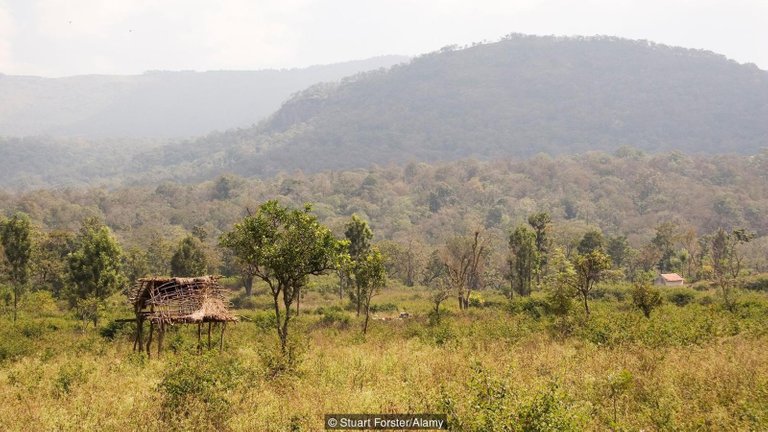In April 2016, there was a rare piece of good news about tigers. For the first time in over a century, the number of tigers went up. The latest global census counted 3,890 tigers, compared to just 3,200 tigers in 2010.
There are lots of reasons for this increase. But one key factor is that, in some places, people are finding ways to live alongside tigers.
India is home to around half of the world's tigers, and in several parts of the country, some local tribes co-exist fairly happily with tigers. That may sound surprising. After all, tigers sometimes kill people, so they might seem like the worst kind of neighbours. But people are living with them regardless.
What's more, these tribal communities might be helping the tigers. Survival International, a charity aiming to protect the rights of indigenous peoples, says "tribal peoples are the best conservationists and guardians of the natural world". That is a big claim, but they have evidence to back it up.

The Biligiriranganna Hills in the BRT Wildlife Sanctuary (Credit: Stuart Forster/Alamy)
In December 2015, Survival International released data on the tigers living in the BRT Wildlife Sanctuary in India's Western Ghats. Between 2010 and 2014, the tiger population nearly doubled.
That population growth rate is markedly higher than the Indian national average. The tigers in question live in a forest alongside an indigenous tribe, the Soliga people.
One possible reason for this conservation success is that the Soligas see the tiger as a deity. "We worship tigers as gods," one Soliga said at the time. "There hasn't been a single incident of conflict with tigers and Soligas or any hunting here."
"We have been the ones that look out for tigers," said another. "You remove us and you remove the tigers."
This coexistence between tigers and humans may be more common than we once thought.

A group of Soligas in BRT Wildlife Sanctuary (Credit: Stuart Forster/Alamy)
Most recently, a study published in May 2016 surveyed people living near the Bor Wildlife Sanctuary in Maharashtra. The researchers found that local people were very tolerant towards tigers.
Their diet may be a factor. The majority of the people are vegetarian, so they do not hunt wild animals for food. This means there are plenty of prey animals for the tigers to hunt.
What's more, because the villagers mostly grow crops, they reported that they actually liked having tigers around because they keep crop-raiding animals in check. Dairy farmers also thought tigers were beneficial, as they dissuade milk thieves from infiltrating the area.
Unlike the Soligas, the people near Bor Wildlife Sanctuary have come into conflict with tigers. A few people, and some livestock, have been killed. But even this has not caused negative attitudes towards tigers.
One reason for this remarkable tolerance is that the local people are Hindus, and believe that the tiger is an animal of transport for the goddess Durga.
But despite these success stories, across India, indigenous tribes are being evicted from protected areas – often in the name of tiger conservation.
Gujjar men riding their ponies to work (Credit: Design Pics Inc/Alamy)
"It seems to me a supreme irony that conservationists haven't realised that the only places where tigers have persisted have been in areas where indigenous tribes are now being evicted," says Sophie Grig of Survival International.
Whether to keep people in the tiger reserves is a contentious issue.
In the 1980s, some of the Gujjar people living in tiger country in northern India were resettled elsewhere. In a study published in 2013, Abishek Harihar of the University of Kent in Canterbury, UK, interviewed some of those who stayed behind. He found that many of them were keen to leave.
"After seeing the lives of their kin improve outside the forests, the remaining Gujjars are willing to entertain the idea of relocating from their traditional homes," says Harihar. He adds that the wildlife recovered "pretty fast" in the areas that were abandoned.
It is not clear if this pattern would be repeated elsewhere. The Gujjars knew that they had over-harvested the natural resources in their forests, and could no longer profitably raise their livestock. As a result, they thought it would be better to move somewhere with access to benefits like education.
But if the Gujjars stay in the forests, and are left in poverty, Harihar is concerned that some of them could be drawn into wildlife poaching, which can be very lucrative.

Tourists watching a Bengal tiger cross the road (Credit: Andy Rouse/naturepl.com)
"There have been a growing number of cases where Gujjars have poisoned buffalo carcasses to kill tigers, and sold them on for their skin and bones to traders," says Harihar.
The community has received little compensation for livestock killed by predators, says Harihar. So they have repeatedly poisoned their livestock to kill tigers. Community members have also become involved with organised poachers.
However, Grig says this problem has been overstated. She contends that she does not know of any tribal people that have been involved in tiger poaching.
"It's always a danger that people may poach tigers for the black market, more so when people are impoverished and feel resentful," she says. "But if you work with the communities, they are less likely to do that."
It will never be easy to live with animals that can kill and eat you or your livestock. But allowing local communities to manage their own ancestral lands could prove to be a big part of the solution. As Harihar says, "working with indigenous people is the key".

A tiger (Credit: Mark Smith/Alamy)




Upvoted you
repost of: http://www.bbc.com/earth/story/20160607-there-are-people-in-india-happily-living-with-wild-tigers
upsssss , that's not so good . I was already impressed reading it and upvoting @salnyart Nice story anyways !
Congratulations @salnyart! You have received a personal award!
Click on the badge to view your own Board of Honor on SteemitBoard.
For more information about this award, click here
Congratulations @salnyart! You have received a personal award!
Click on the badge to view your Board of Honor.
Do not miss the last post from @steemitboard:
SteemitBoard World Cup Contest - Quarter Finals - Day 2
Participate in the SteemitBoard World Cup Contest!
Collect World Cup badges and win free SBD
Support the Gold Sponsors of the contest: @good-karma and @lukestokes
Congratulations @salnyart! You received a personal award!
You can view your badges on your Steem Board and compare to others on the Steem Ranking
Vote for @Steemitboard as a witness to get one more award and increased upvotes!